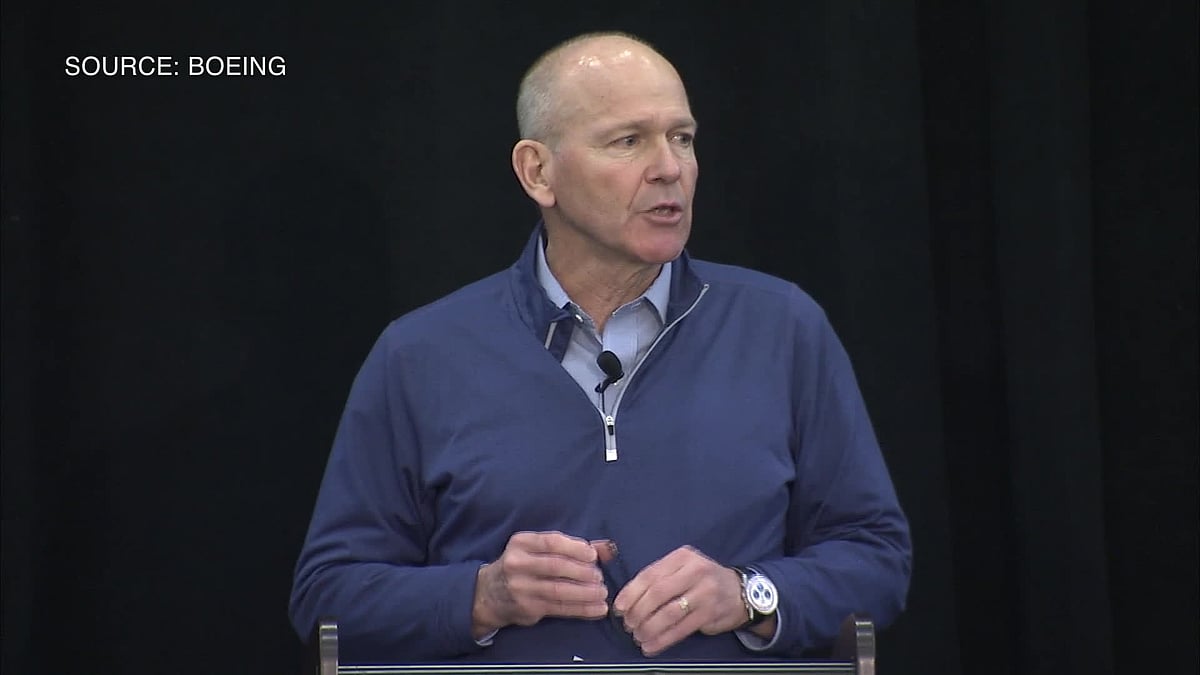Boeing CEO’s Choked-Up Message Walks A Careful Line
The prospect of being sucked out of a faulty airplane at 16,000 feet is enough to bring tears to anyone’s eyes. But showing emotion is tricky for leaders.

(Bloomberg Opinion) -- Boeing Chief Executive Officer Dave Calhoun got emotional at an all-hands meeting as he described the hole blown into the side of one of his company’s planes. I admit to being skeptical when I first read about his public display of feelings. “Oh, come on,” I thought, “Just fix the planes.” Then I watched the video.
“I didn’t know what happened to whoever was supposed to be in that seat next to that hole in the airplane,” said Calhoun, before pausing and apparently changing tacks. His eyes suddenly looking very wet, he blurted out, “I got kids, and I got grandkids, and so do you.”
We live in an era where these all-hands meetings are designed to serve multiple audiences — the employees in the room, investors watching from afar, worried customers. It can be extraordinarily difficult to talk to all these constituencies simultaneously. But ignore this complexity, and a poorly worded phrase or a bit of “inspire the troops” tough talk can make an embarrassing viral clip — something some CEOs have learned the hard way.

Calhoun appeared to strike the right balance with a level of restrained emotion that ought to allow his message — that “every detail matters” when it comes to building planes — to sink in and convince investors and customers that the company is taking the quality-control crisis seriously. But it’s not necessarily a model for other executives who find themselves in a tight spot.
Failing to look genuinely sorry could have been a disaster for Boeing when faith in the safety of the company’s products is deservedly low and the stock has plummeted. A corporate apology delivered by a smiling CEO — or even a neutral, robotic one — will be perceived as fake, research at business schools has found, and won’t restore confidence. An apology where the emotions match the message does more to restore the company’s reputation.
But because leadership always involves an element of public performance, it can be difficult to sound genuine even when the emotion you’re showing is authentic. Executives have to master the art of selectively revealing only those feelings that will help their cause. No one wants to end up like BP’s former CEO, Tony Hayward, who blurted out “I’d like my life back” after the Deepwater Horizon oil spill. I’m sure the sentiment was heartfelt, but it didn’t help his reputation or the company’s. (He ended up apologizing for his apology.) More executives have bungled their contrite messages than not.
Sometimes the emotion simply doesn’t fit the moment. Choking back tears because a human being nearly got sucked out of one of your airplanes at 16,000 feet? Arguably appropriate. Crying publicly because you had to lay off a bunch of people, as more than one executive has done over the last three years? That plays more as self-pity. (It’s fine to cry after firing people — but please, do it in private.)
And too often the emotion doesn’t fit the message. Most corporate apologies involve a fair amount of blame-shifting. How many executives have we heard attribute problems to “unprecedented events,” “market conditions” or “macroeconomic forces?” After the layoffs that started sweeping the technology sector starting in late 2022, leaders at Dell, Microsoft, Salesforce and Google all blamed a broad economic downturn for having to cut staff — although that downturn was mysteriously confined to tech companies that had over-hired. If such thin excuses are accompanied by waterworks, the message reads as “poor me.”
Not everyone’s tears are seen the same way. Studies find that strong emotions, when displayed by middle-age White men, are often perceived as a sign of their passion for the job and thus their commitment. But women who cry at work are often labeled as overly emotional; people of color may be judged as out of control. A young employee might be dismissed as immature or fragile.
And while crying in the workplace is common in some cultures — and some people just find tears come more easily than others — weeping has always been fraught in the Anglo-American business world, where the stiff upper lip still reigns supreme. Arguably we’d benefit from a little more humanity.
Although Calhoun’s display of contrition was appropriate, it wasn’t enough. The best corporate apologies mesh genuine emotion with a clear, specific explanation of what went wrong — something Boeing has yet to diagnose. They also end with a credible promise to fix the problem — something Boeing can’t yet offer.
With years of problems plaguing its planes, the future may bring more tears at Boeing, not fewer.
More From Bloomberg Opinion:
- Airlines and Flyers Are Stuck With 737 Max, Like It Or Not: Brooke Sutherland
- Boeing Becomes the Poor Relation in Duopoly With Airbus: Chris Bryant
- China’s Boeing Alternative Starts to Look Enticing: Tim Culpan
This column does not necessarily reflect the opinion of the editorial board or Bloomberg LP and its owners.
Sarah Green Carmichael is a Bloomberg Opinion columnist and editor. Previously, she was an executive editor at Harvard Business Review.
More stories like this are available on bloomberg.com/opinion
©2024 Bloomberg L.P.